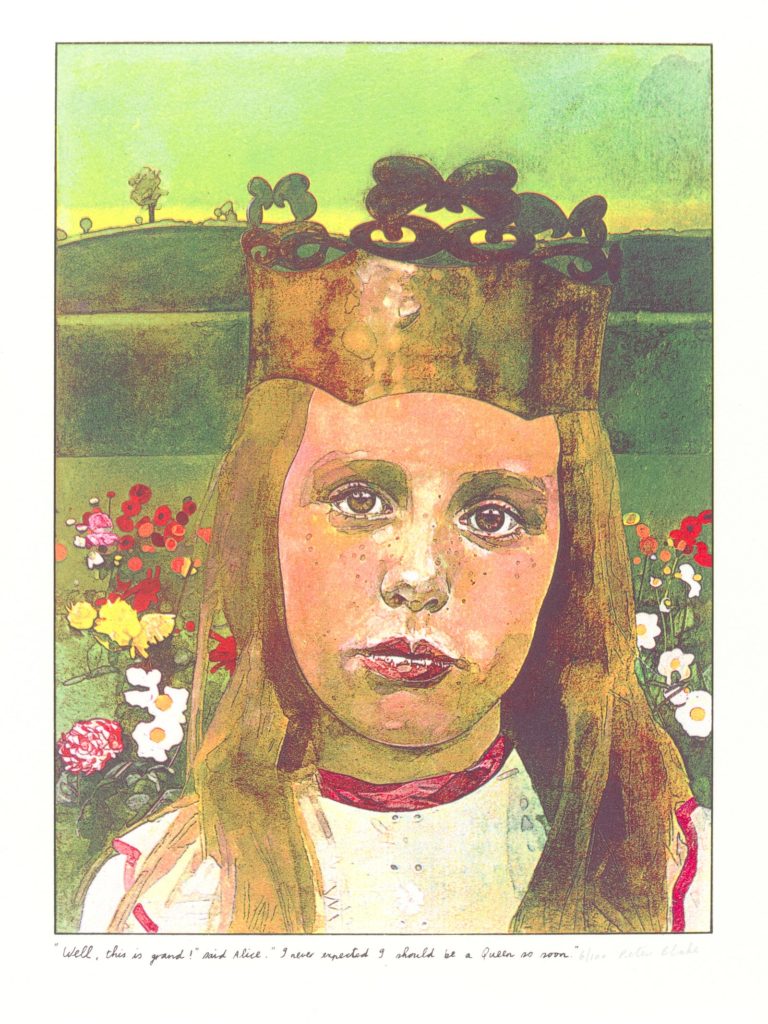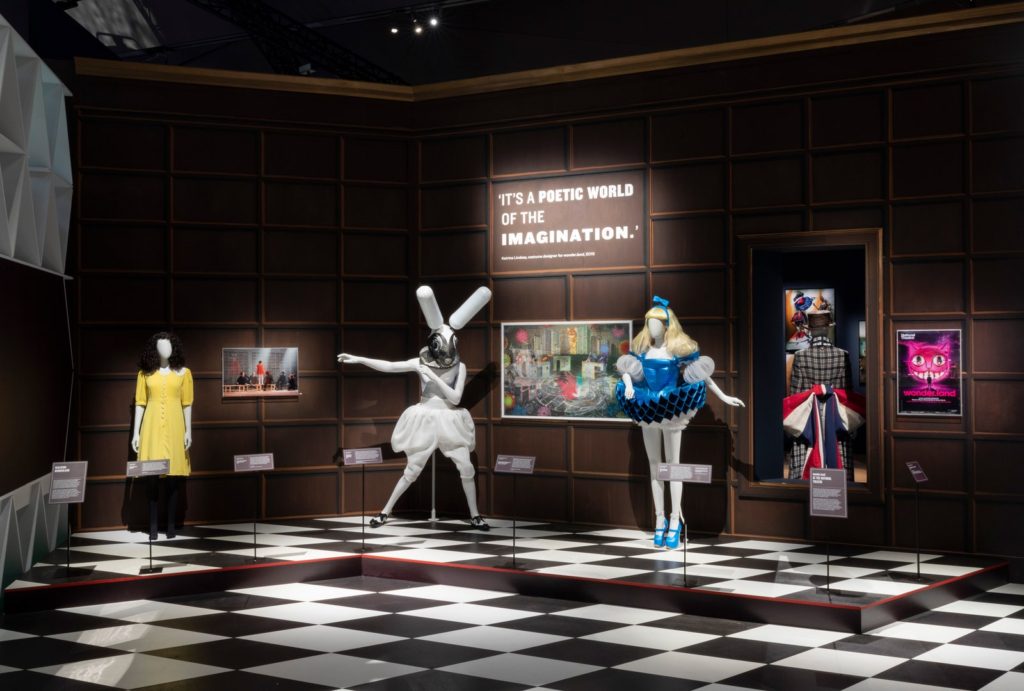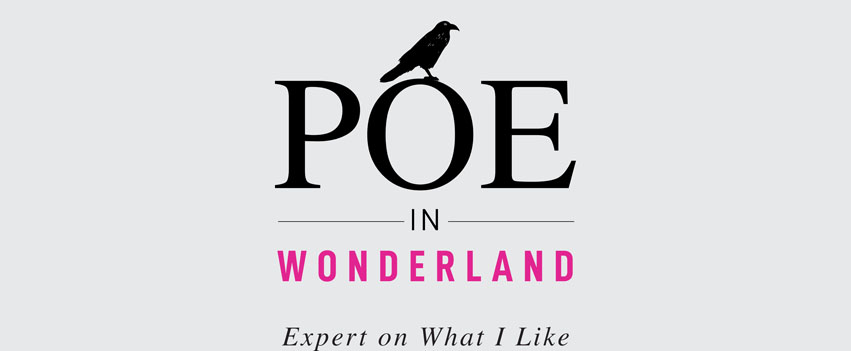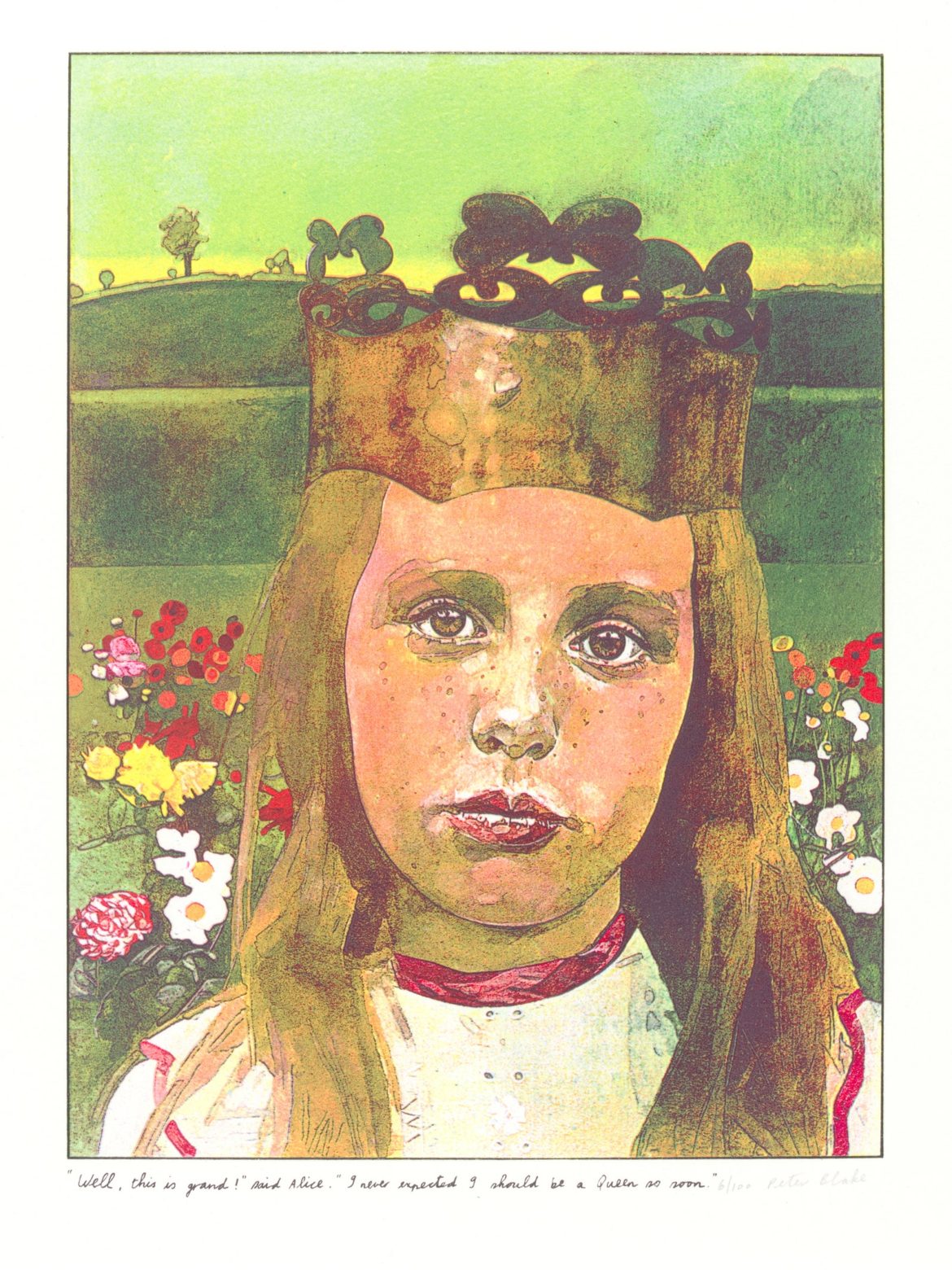Alice in Wonderland is an enduring tale that began as an oral story on July 4, 1862, and was written and delivered by hand to the original Alice – Alice Liddell – on Christmas in 1864. The real-life story of the book is from a summer’s day where Charles Lutwidge Dodgson (Lewis Carroll) rowed his neighbors the 3 Liddell sisters across a lake with a friend. Alice implored him to entertain them, and so he did with what would become a most famous story. Carroll wrote the tale down and illustrated it as a gift to Alice when she was 12 (possibly 11). The Victorians were fascinated by childlike innocence and you couldn’t find such a nonsensical book without a child. For me, it is one of the earliest memories I have of a favorite book. My mother read it to me. I own a 1976 copy she read from as well as a first edition. A new exhibition has opened in London about Alice in Wonderland at the Victoria and Albert Museum and will run through December. I found this interesting article from the New Yorker about the significance of the little girl who fell down a rabbit hole.
The remainder of this post is written by Anna Russell, a contributing writer for the New Yorker.
The Beguiling Legacy of “Alice in Wonderland”
A new exhibition explores the book’s long afterlife.
by Anna Russell
July 11, 2021

Lately, when I can’t sleep, I take a book to the sofa and turn on a reading lamp. Insomnia is lonely—and often infuriating—and it’s a comfort to look at words on a page. Generally, the duller the words the better. In the long predawn hours, I’ve read histories of very old buildings; minor gods; remote, half-forgotten conflicts—and retained practically nothing. But retention is not the point. If you wait long enough—if you are tired enough—something magical will unfold. The sentences will begin to bend and blur together. They will filter into your dreams in surreal, and not unpleasant, ways. At a certain hour, reading becomes a psychedelic experience.
This is especially true of Lewis Carroll’s still trippy “Alice’s Adventures in Wonderland,” from 1865, and its even odder sequel, “Through the Looking-Glass, and What Alice Found There”—both of which I’ve been reading late at night. In the morning, when other books have had their coffee and sobered up, Carroll’s works remain dreamlike and stubbornly nonsensical. “Down, down, down. Would the fall never come to an end?” Carroll writes, as Alice plunges down the rabbit hole. The hole is lined with shelves (naturally), and she plucks a jar of orange marmalade from one as she passes. “I wonder if I shall fall right through the earth!” she frets. “How funny it’ll seem to come out among the people that walk with their heads downwards!”
The origins of Alice’s tumble into Wonderland and its long cultural afterlife—everything from Carroll’s tentative first sketches to cheery, Alice-themed advertisements for Guinness and tomato juice produced a hundred years later (“Welcome to a Wonderland of good drinking!”)—are the subject of a beguiling new exhibition, “Alice: Curiouser and Curiouser,” at the Victoria and Albert Museum, in London. I visited recently. Slipping inside a museum after months of the U.K.’s strict lockdown felt, even masked and distanced, like a revelation; everyone there was buzzing. The show begins down, down in the vast subterranean space of the Sainsbury Gallery, inside a room filled with the sounds of oars hitting the water. It is meant to evoke the now famous day that Charles Lutwidge Dodgson, who later adopted the pen name Lewis Carroll, rowed up the Thames with his friend Robinson Duckworth and the three Liddell sisters, who were neighbors of his: Lorina, Alice, then ten, and Edith. The legend goes like this: one blazing-hot day on the river, the children demanded entertainment and Dodgson obliged, spinning a fantastical tale as they went along. (The real story may be less neat: the weather on July 4th, 1862, the day of the boat trip, was “cool and rather wet,” according to some sources.) Alice asked Dodgson to write the story down for her, and, on Christmas, 1864, he handed her the finished manuscript, then called “Alice’s Adventures Under Ground.” He was meticulous; it had no mistakes. The last page featured a small photo of Alice’s face and, underneath, a portrait of her that Dodgson had drawn by hand.
Dodgson’s original manuscript, on loan from the British Library, is a strikingly beautiful and strange object, the cover decorated with a border of unruly wildflowers, like an overgrown garden. Carefully hand-lettered and illustrated by Dodgson in fine, spindly pen, the care he has taken in weaving the drawings into the minute text is evident. (“What is the use of a book,” Alice wonders early in the tale, “without pictures or conversation?”) The dedication, embellished with curling green vines, reads, “A Christmas Gift to a Dear Child in Memory of a Summer Day.” When I saw the show, which runs until the end of December, the little book had been flipped open to reveal a page featuring one of Dodgson’s illustrations of Alice. In the story, she has just eaten a mysterious cake (there’s a card on top, and “the words ‘eat me’ were beautifully printed on it in large letters”) and she finds herself stretching upward, her neck elongated, almost beyond the confines of the book, “like the largest telescope that ever was!” “Curiouser and curiouser!” she says.
Curious would be the way to describe the Victorians of Alice’s day. The show’s curator, Kate Bailey, has evoked the era’s flurry of discovery and industry, its devotion to science and progress, with a carrousel of delightful oddities: an eighteen-fifties kaleidoscope, an unwieldy folding-box camera of the kind Dodgson used, the skeleton of a dodo. There’s an accordion-like paper model of Hyde Park’s “Great Exhibition,” a manufacturing-and-design showcase that blew everyone’s mind in 1851. (Dodgson called it “a sort of fairyland.”) There’s a fascination with childhood on display as well, which seems to have started at the top, with Queen Victoria, who had nine children; a sepia-colored photograph shows a placid child balanced on her lap. “Attitudes towards childhood changed in the 19th century,” the explanatory text reads, “moving away from puritanical ideas of original sin towards associations with freedom, creativity and innocence.” The Victorians were “preoccupied and fascinated by childhood, and by the child,” Bailey told me, recently. “That was the moment where children’s literature emerged.”
The real Alice Liddell was the daughter of Henry Liddell, the dean of Christ Church college at Oxford University, where Dodgson taught mathematics. Early in the show, there’s an arresting photo of Alice taken by Dodgson, in 1858. She’s seated in profile and dressed like a Victorian doll: ruffled sleeves, dark bob. She looks serious and maybe a little impatient. In the course of Alice’s lifetime, Dodgson photographed her many times. He lived next door—his study overlooked the garden where she played with her sisters—and was a frequent visitor at her family’s home. He was obviously smitten, perhaps inappropriately so, though the nature of Dodgson’s relationship with Alice is not something that the exhibition investigates. (There is no clear evidence that Dodgson crossed the line, just lingering suspicions). A single placard under a photograph of the Liddell sisters reads, “Today Dodgson’s close friendship with Alice Liddell would be scrutinised, but in Victorian times it was not viewed as inappropriate for a man to befriend a younger girl.” Bailey told me that she wanted to make a show about the “impact and legacy of the books, as opposed to really scrutinizing the biography of Lewis Carroll.”

Photograph courtesy Victoria and Albert Museum
From a darkened room steeped in Victoriana, you turn a literal corner and find yourself in a hallway in which the walls appear to be shrinking. Or perhaps you are simply growing larger. At the end, there’s a small door behind a curtain. Peek into its tiny windows and you’ll see a walled garden, complete with neat hedges and pink flamingos. (“She knelt down and looked along the passage into the loveliest garden you ever saw,” an inscription on the door reads.) Round another corner and there’s a digital pool of tears, like the one Alice suddenly found herself swimming in (“ ‘I wish I hadn’t cried so much!’ ”) From there, things only get stranger, with rooms building on one another freely, like actors in an improv class. There’s a space that resembles a down-on-its-luck seaside pier, with a striped pavilion full of mirrors and backward writing. (“Who in the world am I? Ah, that’s the great puzzle!”) There’s also an arcade-like machine with a hand crank that causes Alice to stretch comically upward. (Hand sanitizer provided.) A lazy caterpillar on stilts oversees it all.
In these rooms, we see Alice undergo transformation after transformation. She has definitely eaten something weird. There are John Tenniel’s exquisite sketches for the first published version of the book, in which Alice possesses flowing pre-Raphaelite locks and an unusually large head. (The real Alice’s messy brunette bob has disappeared.) She is played by a flustered teen in a ten-minute silent film by Cecil M. Hepworth and Percy Stow, from 1903. In 1933, Paramount put out a much publicized live-action “Alice” filled with stars, including W. C. Fields as Humpty Dumpty and Gary Cooper as the bumbling White Knight. (Even Cary Grant, as a nearly unrecognizable Mock Turtle, couldn’t save the film; it was a box-office bomb.) The most enduring cinematic image of Alice comes, of course, from the animated Disney version, released in 1951. In development as early as 1933, the project stalled during the Second World War and hit numerous creative dead ends. (Disney rejected a treatment by Aldous Huxley for being “too literary.”) The Alice that emerged—blond with a blue dress, black hairband, and perfect manners—and the bright block colors of the film come mainly from the brilliant concept artist Mary Blair, whose work is on display. Disney’s Alice is sweetly affecting, but I prefer Carroll’s more pointed version. Carroll’s Alice is polite in a knowing, English way. Even while conversing with a strung-out caterpillar, she seems to be saying, I know that you’re strange, but I won’t say anything about it. It’ll only embarrass us both.
Spending time with Alice, you get the sense that people make of her what they want. A bevy of surrealist artists, including Dorothea Tanning and Max Ernst, were drawn to the darker strands of the books—Alice’s disorientation, the unyielding nonsense of it all—and they painted disturbing pictures of her wandering flower-strewn hallways, hair on end, or embedded in solid rock. (Tanning’s splendid “Eine Kleine Nachtmusik,” from 1943, appears in the catalogue, though not in the exhibition.) Salvador Dalí, once an artist-in-residence at Disney, illustrated a special edition of the tale, in 1969. His images, splashed across one gallery, are free-flowing and luminous, each with a minute ink drawing of Alice tucked somewhere in the dreamscape. (In one, “A Mad Tea Party,” a tree pierces the center of a melting clock.) Members of the counterculture of the nineteen-sixties also loved Alice, and there’s a photograph of Yayoi Kusama and a merry band of naked, polka-dot-covered dancers posing on the Alice sculpture in Central Park. There’s a still from Jonathan Miller’s 1966 BBC adaptation, in which Alice appears as a stony-faced teen-ager in a world of incomprehensible adults. (Ravi Shankar provides a dreamy, sitar-laced soundtrack.) A poster by the San Francisco printmakers East Totem West shows a grinning Cheshire cat in psychedelic colors (“We’re All Mad”). On a wall nearby, there’s a mesmerizing video of Grace Slick with Jefferson Airplane, belting out the lyrics to “White Rabbit.” With her bracingly angelic features and deep stare, Slick looks like Alice on LSD. “One pill makes you larger, and one pill makes you small,” she sings. “Go ask Alice when she’s ten feet tall.”
All that growing and shrinking, the mushroom-eating, the polka-dot-painting: it’s enough to make you wonder what the real Alice would have thought. The exhibition includes a small picture, by an unknown photographer, of Alice Hargreaves (née Liddell) arriving by ship in New York in 1932. By that time, she was eighty and had lived a relatively quiet life in England. After leaving Oxford, she travelled around Europe with her sisters, married a cricketer, and raised three sons (one of whom she named Caryl). In 1928, she made headlines by selling the original manuscript that Dodgson had given her as a child. She was widowed and needed the money. In the photo, she is smiling, dressed jauntily in a hat and white gloves, and holds a copy of “Alice.” She gamely helped promote Paramount’s film, in 1933, and she never had a bad word to say about Dodgson, but it must have been a long haul. “But oh my dear I am tired of being Alice in Wonderland,” she wrote to her son toward the end of her life. “Does it sound ungrateful? It is. Only I do get tired.”
In the final part of the show, as Alice enters the twenty-first century, there’s no sign of her influence abating. She seems to be everywhere at once. There are sublimely intricate costumes from productions at the Royal Opera House (“Alice’s Adventures in Wonderland”) and the National Theatre (“wonder.land”). There’s Stephen Jones’s Mad Hatter hat and a decadent series of Wonderland-inspired photographs by Tim Walker featuring an all-Black group of artists and celebrities. (RuPaul, on a throne of cards, is the Queen of Hearts.) Near the end of the exhibit, a little overstimulated, I sat down gratefully beneath a tangle of oversized flowers and accepted a V.R. headset for an experience titled “A Curious Game of Croquet.” I fell, lurchingly, down a digital rabbit hole, looking up and around before hitting the ground. I wandered through a tiny door and into a sprawling garden. By the time I got there, nothing felt more natural to me than to be drafted into a game. I picked up a hedgehog and played.
Poe in Wonderland
If you enjoyed this article, you might like our own featured Alice ones:
ALiCe in WoNdErLaNd Illustrations by Ralph Steadman
Alice in Wonderland Facts
Alice in Wonderland’s 1903 First Silent Movie Adaptation with New Soundtrack
and the fabulous Alice in Wonderland Tart Adage is Wonderful

